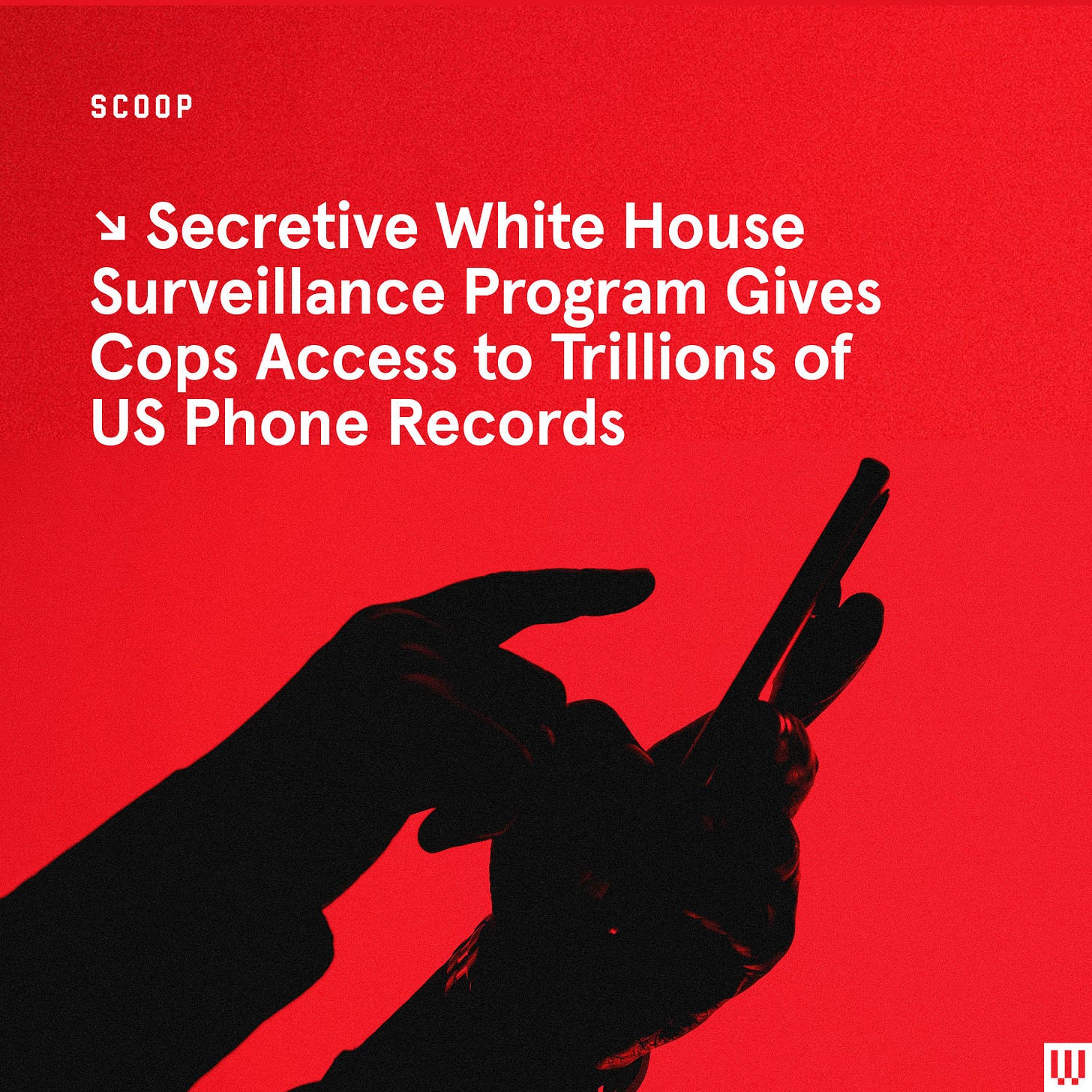Secretive White House Surveillance Program Gives Cops Access to Trillions of US Phone Records
A WIRED analysis of leaked police documents verifies that a secretive government program is allowing federal, state, and local law enforcement to access phone records of Americans who are not suspecte
A little-known surveillance program tracks more than a trillion domestic phone records within the United States each year, according to a letter WIRED obtained that was sent by US senator Ron Wyden to the Department of Justice (DOJ) on Sunday, challenging the program’s legality.
According to the letter, a surveillance program now known as Data Analytical Services (DAS) has for more than a decade allowed federal, state, and local law enforcement agencies to mine the details of Americans’ calls, analyzing the phone records of countless people who are not suspected of any crime, including victims. Using a technique known as chain analysis, the program targets not only those in direct phone contact with a criminal suspect but anyone with whom those individuals have been in contact as well.
The DAS program, formerly known as Hemisphere, is run in coordination with the telecom giant AT&T, which captures and conducts analysis of US call records for law enforcement agencies, from local police and sheriffs’ departments to US customs offices and postal inspectors across the country, according to a White House memo reviewed by WIRED. Records show that the White House has, for the past decade, provided more than $6 million to the program, which allows the targeting of the records of any calls that use AT&T’s infrastructure—a maze of routers and switches that crisscross the United States.
In a letter to US attorney general Merrick Garland on Sunday, Wyden wrote that he had “serious concerns about the legality” of the DAS program, adding that “troubling information” he’d received “would justifiably outrage many Americans and other members of Congress.” That information, which Wyden says the DOJ confidentially provided to him, is considered “sensitive but unclassified” by the US government, meaning that while it poses no risk to national security, federal officials, like Wyden, are forbidden from disclosing it to the public, according to the senator’s letter.
AT&T spokesperson Kim Hart Jonson declined WIRED’s request to comment on the DAS program, saying only that the company is required by law to comply with a lawful subpoena.
There is no law requiring AT&T to store decades’ worth of Americans’ call records for law enforcement purposes. Documents reviewed by WIRED show that AT&T officials have attended law enforcement conferences in Texas as recently as 2018 to train police officials on how best to utilize AT&T’s voluntary, albeit revenue-generating, assistance.
MOST POPULAR
BUSINESS
OpenAI Staff Threaten to Quit Unless Board Resigns
WILL KNIGHT
BUSINESS
Why Teslas Totaled in the US Are Mysteriously Reincarnated in Ukraine
AARIAN MARSHALL
BUSINESS
How OpenAI’s Bizarre Structure Gave 4 People the Power to Fire Sam Altman
PARESH DAVE
GEAR
The 47 Best Black Friday Deals on Outdoor Gear
SCOTT GILBERTSON
In 2020, the transparency collective Distributed Denial of Secrets published hundreds of gigabytes of law enforcement data stolen from agencies around the US. A WIRED review of the files unearths extraordinary detail regarding the processes and justifications that agencies use to monitor the call records of not only criminal suspects, but of their spouses, children, parents, and friends. While DAS is managed under a program devoted to drug trafficking, a leaked file from the Northern California Regional Intelligence Center (NCRIC) shows that local police agencies, such as those in Daly City and Oakland, requested DAS data for unsolved cases seemingly unrelated to drugs.
In one instance, an officer with the Oakland Police Department asked for a “Hemisphere analysis” to identify the phone number of a suspect by analyzing the calls of the suspect’s close friends. In another, a San Jose law enforcement officer asked the Northern California Regional Intelligence Center to identify a victim and material witness in an unspecified case. One officer, soliciting information from AT&T under the program, wrote: “We obtained six months of call data for [suspect]'s phone, as well as several close associations (his girlfriend, father, sister, mother).” The records do not indicate how AT&T responds to every request.
Leaked law enforcement files further show that a range of officials—from a US Postal Service inspector to a New York Department of Corrections parole officer—participated in DAS training sessions. Other participants include port authorities and members of US Immigration & Customs Enforcement, National Guard, and California Highway Patrol, alongside scores of smaller agencies.
First disclosed by The New York Times in September 2013 as Hemisphere, the DAS program—renamed in 2013—has since flown largely under the radar. Internal records concerning the program’s secrecy that were obtained by the newspaper at the time show that law enforcement had long been instructed to never “refer to Hemisphere in any official document.”
Following the Times’ story, former US president Barack Obama reportedly suspended funding for the Hemisphere program in 2013. And while discretionary funding was withheld over the following three years, a White House memo obtained by WIRED shows that individual law enforcement organizations across the US were permitted to continue contracting with AT&T directly in order to maintain access to its data-mining service. Funding resumed under former president Donald Trump but was halted again in 2021, according to the White House memo. Last year, under president Joe Biden, the funding resumed once more, the memo says.
MOST POPULAR
BUSINESS
OpenAI Staff Threaten to Quit Unless Board Resigns
WILL KNIGHT
BUSINESS
Why Teslas Totaled in the US Are Mysteriously Reincarnated in Ukraine
AARIAN MARSHALL
BUSINESS
How OpenAI’s Bizarre Structure Gave 4 People the Power to Fire Sam Altman
PARESH DAVE
GEAR
The 47 Best Black Friday Deals on Outdoor Gear
SCOTT GILBERTSON
The White House acknowledged an inquiry from WIRED but has yet to provide a comment.
THE DAS PROGRAM is maintained under an affiliated program called HIDTA, funded by the White House’s Office of National Drug Control Policy (ONDCP). HIDTA, or “high-intensity drug trafficking area,” is a designation assigned to 33 different regions of the US, according to the White House. The first five regions, mapped out in 1990, included areas around Los Angeles, Houston, Miami, New York, and the entire US-Mexico border, some of the nation’s most active drug trafficking areas.
The collection of call record data under DAS is not wiretapping, which on US soil requires a warrant based on probable cause. Call records stored by AT&T do not include recordings of any conversations. Instead, the records include a range of identifying information, such as the caller and recipient’s names, phone numbers, and the dates and times they placed calls, for six months or more at a time. Documents released under public records laws show the DAS program has been used to produce location information on criminal suspects and their known associates, a practice deemed unconstitutional without a warrant in 2018.
“Requests concerning location information require the highest level of legal demand, which is a court-issued warrant, except in emergency situations,” AT&T’s Hart Jonson says.
Orders targeting a nexus of individuals are sometimes called “community of interest” subpoenas, a phrase that among privacy advocates is synonymous with dragnet surveillance.
“The scale of the data available to and routinely searched for the benefit of law enforcement under the Hemisphere Project is stunning in its scope,” Wyden’s letter to Garland says.
The White House has provided at least $6.1 million in discretionary funding to the DAS program since 2013, according to a two-page memo authored last year by White House officials. An internal HIDTA “participant guide” reviewed by WIRED shows that HIDTA funding exceeded $280 million in 2020 alone. It remains unclear how much HIDTA funding is spent to support AT&T’s vast collection of American call records.
It is not currently known how far back the call records accessible under DAS go. A slide deck released under the Freedom of Information Act in 2014 states that up to 10 years’ worth of records can be queried under the program, a statistic that contrasts with other internal documents that claimed AT&T could reach decades into the past. AT&T’s competitors, meanwhile, typically retain call records for no more than two years. (The necessity for phone companies to track call records for extended periods of time has gradually decreased with the disappearance of long-distance charges.)
MOST POPULAR
BUSINESS
OpenAI Staff Threaten to Quit Unless Board Resigns
WILL KNIGHT
BUSINESS
Why Teslas Totaled in the US Are Mysteriously Reincarnated in Ukraine
AARIAN MARSHALL
BUSINESS
How OpenAI’s Bizarre Structure Gave 4 People the Power to Fire Sam Altman
PARESH DAVE
GEAR
The 47 Best Black Friday Deals on Outdoor Gear
SCOTT GILBERTSON
THE DAS PROGRAM echoes multiple dragnet surveillance programs dating back decades, including a Drug Enforcement Agency program launched in 1992 that forced phone companies to surrender records of virtually all calls going to and from over 100 other countries; the National Security Agency’s bulk metadata collection program, which the US Second Circuit Court of Appeals deemed illegal in 2014; and the Call Details Records program, which suffered from “technical irregularities” leading the NSA to collect millions of calls it was “not authorized to receive.”
Unlike these past programs, which were subject to congressional oversight, DAS is not. A senior Wyden aide tells WIRED the program takes advantage of numerous “loopholes” in federal privacy law. The fact that it’s effectively run out of the White House, for example, means it is exempt from rules requiring assessments of its privacy impacts. The White House is also exempt from the Freedom of Information Act, reducing the public’s overall ability to shed light on the program.
Because AT&T’s call record collection occurs along a telecommunications “backbone,” protections enshrined under the Electronic Communications Privacy Act may not apply to the program.
Earlier this month, Wyden and other lawmakers in the House and Senate introduced comprehensive privacy legislation known as the Government Surveillance Reform Act. The bill contains numerous provisions that, if enacted, would patch most if not all of these loopholes, effectively rendering the DAS program, in its current form, explicitly illegal.
Campamento Tortuguero Playa Hermosa is a turtle sanctuary on Bonfil Beach outside of Acapulco that rescues sea turtle eggs that would be likely destroyed by vehicles on the beaches or pilfered by tourists. The sanctuary protects the eggs, hatches them and releases the babies into the ocean while protecting them from seagulls and other winged predators.
The 35-year-old sanctuary is run by the mother/daughter duo of Monica and Michel Vallarino, who have helped educate the community and the tourists on the ecology of the turtles while simultaneously providing a refuge for puppies, kittens, ducks, rabbits, and other wayward animals.
The Art of Liberty Foundation hosted an annual fundraiser from 2018-2020 called the Art of Liberty on the Beach (aKa The Turtle Party), where many of the leading artists in the liberty movement have rocked the sanctuary including Grant "Prezence" Ellman, Truniversal/Free Willow, Alais Clay, the Freenauts, DJ Koala, DJ Ramiro Romani and ELA-mental among others.
The sanctuary was devasted by Hurricane Otis, a category five hurricane that hit Acapulco and Bonfil Beach on November 2nd 2023.
25% of Funds Raised Will Benefit Other Residents of Bonfil Beach.
The Art of Liberty Foundation is organizing a fundraiser where 100% of the proceeds will go to direct relief. The Vallarinos have agreed to share 25% of the proceeds with other Bonfil Beach residents in need to be distributed at their discretion.








Great,.....hey I know . Let’s all change our phone numbers. 😁